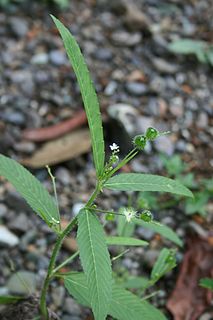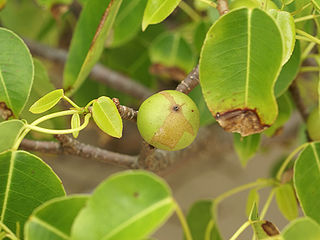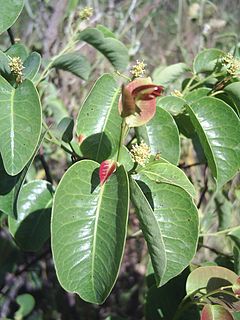Tacarcuna is a genus of plants in the Phyllanthaceae first described as a genus in 1989. It is native to Panama, Colombia, Venezuela, and Peru.
- Tacarcuna amanoifoliaHuft - Loreto Region in Peru; Amazonas Department in Colombia
- Tacarcuna gentryiHuft - Darién Province in Panama, Magdalena Department in Colombia
- Tacarcuna tachirensisHuft - Táchira State in Venezuela
Caryodendron is a plant genus of the family Euphorbiaceae first described as a genus in 1860. The genus includes C. orinocense, known as the Inchi tree or Tacay nut. It is native to Central America and South America.
- Caryodendron amazonicumDucke - Amazonas in Brazil
- Caryodendron angustifoliumStandl. - Costa Rica, Panama, Colombia
- Caryodendron janeirenseMüll.Arg. - Rio de Janeiro
- Caryodendron orinocenseH.Karst - Colombia, Venezuela, Ecuador

Caperonia is a genus of plants of the family Euphorbiaceae first described as a genus in 1825. The genus is native to tropical and subtropical America and Africa.

Tetrorchidium is a genus of flowering plants in the family Euphorbiaceae first described in 1841. It is native to tropical portions of Africa and the Western Hemisphere.
Acidocroton is a genus of plants under the family Euphorbiaceae first described with this name in 1859. It is native to Colombia and the Greater Antilles.

Hippomane is a genus of plants in the Euphorbiaceae described by Linnaeus in 1753. It is native to the West Indies, Central America, Mexico, Florida, Venezuela, Colombia, and Galápagos.

Maprounea is a plant genus of the family Euphorbiaceae first named as a genus in 1775. It is native to tropical Africa, Trinidad, and tropical Central and South America.
- Maprounea africana - W + C + S Africa, from Benin to Zimbabwe
- Maprounea amazonica - Colombia, Venezuela, N Brazil
- Maprounea brasiliensis - Brazil, Paraguay, Bolivia
- Maprounea guianensis - Trinidad, Panama, Colombia, Venezuela, French Guiana, Suriname, Guyana, Brazil, Peru, Ecuador, Bolivia, Paraguay
- Maprounea membranacea - Nigeria, Cameroon, Gabon, Equatorial Guinea, Cabinda, Central African Republic, Congo, Zaire
Discocarpus is a genus of the plant family Phyllanthaceae first described as a genus in 1841. It is native to northern South America.
- Discocarpus essequeboensisKlotzsch - Brazil, Venezuela (Amazonas), Guyana, Suriname, French Guiana
- Discocarpus gentryiS.M.Hayden - S Venezuela (Amazonas), Peru (Loreto), N Brazil
- Discocarpus pedicellatusFiaschi & Cordeiro - State of Bahia in Brazil
- Discocarpus spruceanusMüll.Arg. - Venezuela (Amazonas), Brazil, Suriname (Sipaliwini), Bolivia

Perrottetia is a genus of flowering plants in the family Dipentodontaceae described as a family in 1824. Species occur in China, Southeast Asia, Papuasia, Hawaii, Australia, and Latin America. It is the largest genus of the recently described order Huerteales.

The Tacarcuna wood quail is a species of bird in the family Odontophoridae. It is found in Colombia and Panama. Its natural habitat is subtropical or tropical moist montane forests. It is threatened by habitat loss.
Crossothamnus gentryi is a flowering tree in the family Asteraceae. It is found in Ecuador and Peru. Its natural habitat is subtropical or tropical moist montane forests. It is threatened by habitat loss.
Crossothamnus is a genus of South American flowering plants in the sunflower family.

Gustavia is a genus of flowering plants in the family Lecythidaceae described by Linnaeus in 1775. It is native to tropical Central America and South America. Many of the species are threatened; some are critically endangered Gustavia superba, though, is actually abundant in re-growing secondary forests. It grows in northern South America, from Panama south through the Andes as far as Ecuador, and along the Caribbean coast and in the Amazon basin.
Pseudolmedia is a flowering plant genus in the mulberry family (Moraceae). Species are found in southern Mexico, the Caribbean, and Meso- and South America. They are known in Latin America as lechechiva and used for timber, construction wood, and sometimes in folk medicine.
Dresslerothamnus is a genus of flowering plants in the daisy family.
Ferreyranthus is a genus of South American flowering plants in the daisy family.

Lasianthaea is a genus of flowering plants in the daisy family. The species are native primarily to Mexico, with one species extending just over the border into the United States and another south to northwestern South America.

Alwyn Howard Gentry was an American botanist and plant collector, who made major contributions to the understanding of the vegetation of tropical forests.
Prunus gentryi is a species of wild cherry in the genus Prunus, family Rosaceae, native to the Mexican states of Chihuahua and Sonora. It grows along streambanks in mountainous regions of the Sierra Madre Occidental. The scientific description was published in 1937.
Stillingia parvifolia is a species of flowering plant in the family Euphorbiaceae. It was described in 1989. It is native to Peru.








